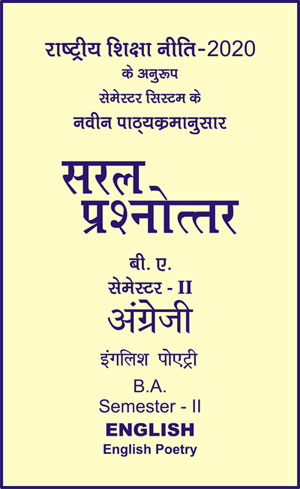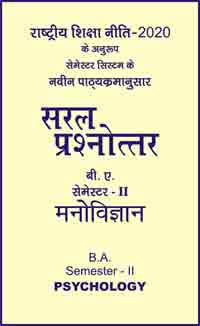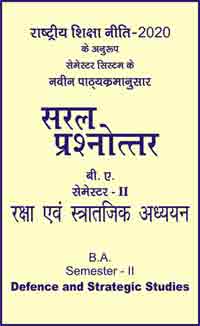|
बी ए - एम ए >> बीए सेमेस्टर-2 - अंग्रेजी - इंगलिश पोएट्री बीए सेमेस्टर-2 - अंग्रेजी - इंगलिश पोएट्रीसरल प्रश्नोत्तर समूह
|
5 पाठक हैं |
|||||||
बीए सेमेस्टर-2 - अंग्रेजी - इंगलिश पोएट्री
Chapter - 9
"Ode on a Grecian Urn"
- John Keats
Life and Works of John Keats
John Keats was born in 1795, the eldest of four children. His father was an osteler in a lively stable. His origins and surroundings were too unpoetic to inspice poetry in him. He was sent to a school at Enfield where he lived, the boy attracted the interest of the head master, cowden clarke and his son. They aroused his liteary talents in him who as a small boy showed little poetic promise and in 1813 gave him spenser's poetry which so fired his imagination that poetry became immediately and permanently the one great interest in his life, though until 1815 he was being trained as a medical student. He left school at the age of fifteen and was apprenticed to a surgeon, but the company of the Head master, his sons and the school library was still accessible to him. In 1815 he entered a hospital in London. But he was not interested there and left the hospital. In 1817 a small volume of his poems was published and next year his 'Endymion' which was bitterly criticised by Blackwood's Magazine and quarterly review with the result that it soon ceased to sell. Keats expresses his fellings caused by these criticisms: "I begin to get a little acquainted with any own strength and weakness praise or blame has but a momentory effect on the man whose love of beauty in the abstract make him a savere critic of his won works."
In 1818 his brother Tom fell ill whom he nursed with a mother's devotion and when he died Keat's health was much impaired. Tom died of consumption. Upon Tom's death Keats moved to Brawn's house in hamp stead. It was here that he developed a passion for Fanny Brawn a young beauty of the far from uncommon English hawk blond type. After some times he was ordered to Italy by physicians. He accompainied by seven went first to Naples but travelled back to Rome in the hope of regaining some measure of health. But all in vain on February 23, 1821. Severn writes - I shall die essay don't be frightened - be firm and thank God it has come.' I lifted him up in may arms. The phlegm seemed boiling in his throat and increased until eleven, when he gradually sank into death, so quiet, that I still thought he slept," During the last year of Kis life he had been very productive.
Ode on a Grecian Urn
Introduction to the Poem
The poet personifies the Grecian urn and calls if and unravished bride of quietness, a foster child of silence and slow time a chronicter of forest life of ancient times. The poet that appeal to the spirit are that the melodies which have appeal for the sensual ear. The young man singing beneath the tree will remain singing for ever. The branches of the trees carved on urn will enjoy perpetual spring. They will never bid, farewell to spring. Autumn or the changes of season will never deptive them of their freshness and colour. He will never be disappointed as the lovers in actual life are. He will never known the pangs of love-love that leaves a during head and a parched tongue in actual life.
Keats sympahty with the post, in this Ode, is coloured with regret, the brede of marble men and maidens so near to life; the urn is but a mute witness to things. Keats reads the lesson of the identity pleasure in the beautiful impressions and his power of giving them, being in his verse, but also the clearest, statement of philosophy which guided his life -
"Beauty is truth, Truth beauty-that is all
Ye know on earth and all ye need to know."
Substance of the Poem
The poet personifies the Grecian urn and calls it an unravished bride of quietness, a foster child of silence and slow time a chronicier of forest life of ancient times. The picture of beautiful men and women craved on the marble and strange and mysterious like eternity. We do not know what these pictures are exactly about. When the present generation will grow old and die, the urn. The new generation with its new miseries and woes will take place. The Grecian urn will tell the world that beauty and truth are one and the same things.
कविता का हिन्दी सारांश
कवि यूनानी पात्र का मानवीकरण करता है और शांति की पवित्र लज्जाशील दुल्हन, शांति का पुत्र औन वन में रहने वाले मनुष्यों की कहानियों को तथा उसके इतिहास को रचने वाला कहकर संबोधित करता है । कवि उन कहानियों को जो पात्र पर खुदी हुयी औरतों व आदमियों की सुन्दर तस्वीरे पात्र में जो अंकित हैं, वे विचित्र और रहस्यमय हैं। हम नहीं जानते कि ये चित्र किससे संबंधित हैं। जब आज की पीढ़ी वृद्ध हो जाएगी और फिर समाप्त हो जाएगी, तब नयी पीढ़ी अपने नये दुखों और कष्टों के साथ उभरेगी। यूनानी पात्र संसार को स्पष्ट करेगा कि सुन्दरता और सत्य एक ही चीज है।
Points to Ponder (About the Poem)
1. The poem is a fine illustration of Keats power of entering into the spirit of another age.
2. The ode shows the full force of Hellenic influence acting on temperament essentially romantic.
3. The central thought of this ode is unity of Truth and Beauty.
4. Keats Ode on a graecian urn images the picture of beautiful men and women craved on the marble and strange and mysterious like eternity.
|
|||||
- Chapter - 1 Forms of Poetry & Stanza Forms
- Objective Type Questions
- Answers
- Chapter - 2 Poetic Device
- Objective Type Questions
- Answers
- Chapter - 3 "Let Me Not to the Marriage of True Minds" (Sonnet No. 116)
- Objective Type Questions
- Answers
- Chapter - 4 "On His Blindness"
- Objective Type Questions
- Answers
- Chapter - 5 "Present in Absence"
- Objective Type Questions
- Answers
- Chapter - 6 "Essay on Man”
- Objective Type Questions
- Answers
- Chapter - 7 "Elegy Written in a Country Churchyard”
- Objective Type Questions
- Answers
- Chapter - 8 "The World is Too Much with Us"
- Objective Type Questions
- Answers
- Chapter - 9 "Ode on a Grecian Urn"
- Objective Type Questions
- Answers
- Chapter - 10 "Break, Break, Break"
- Objective Type Questions
- Answers
- Chapter - 11 "How Do I Love Thee?"
- Objective Type Questions
- Answers
- Chapter - 12 "Dover Beach"
- Objective Type Questions
- Answers
- Chapter - 13 "My Last Duchess'
- Objective Type Questions
- Answers
- Chapter - 14 "The Love Song of J. Alfred Prufrock"
- Objective Type Questions
- Answers
- Chapter - 15 "The Lake Isle of Innisfree"
- Objective Type Questions
- Answers
- Chapter - 16 "Church Going"
- Objective Type Questions
- Answers
- Chapter - 17 Rhetoric and Prosody - Practical Criticism
- Objective Type Questions
- Answers














